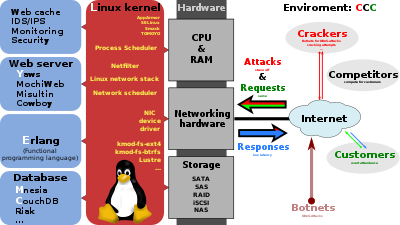LYME (software bundle)
The stacks are composed of: The LYME and LYCE bundles can be and are combined with many other free and open-source software packages such as e.g. netsniff-ng for security testing and hardening, Snort, an intrusion detection (IDS) and intrusion prevention system (IPS), RRDtool for diagrams, or Nagios, Collectd, or Cacti, for monitoring.As a result of using Erlang, LYME and LYCE applications perform well under high load[1] and if distribution and fault tolerance is needed.Interest in LYME as a stack had begun by August 2005,[3] as was soon cited as a high-performance web application platform that used a single development language throughout.Comparisons to LAMP have also been favourable,[citation needed] although some[4] have highlighted the difficulties of porting "SQL thinking" to the very different context of Mnesia.Besides Mnesia and CouchDB, there are a couple of other databases written in Erlang, e.g., Cloudant, Couchbase Server (born as Membase), database management system optimized for storing data behind interactive web applications, Riak, and SimpleDB (part of Amazon Web Services[7]).
software stacksfree and open-source softwaredynamic web pagesoperating systemweb serverMnesiaCouchDBdatabaseErlangfunctional programming languagenetsniff-ngintrusion detectionintrusion prevention systemRRDtoolNagiosCollectdvirtual machineApachePythonprocessdata manipulation languageRuby on RailsKlarnafunctional programmingCloudantCouchbase ServerSimpleDBAmazon Web ServicesLAMP (software bundle)MEAN (software bundle)Uppsala UniversityLinux kernelHistoryLinus's lawLinux-libreBooting processKernel oopsCriticism of LinuxCriticism of desktop LinuxGNU/Linux naming controversyTanenbaum–Torvalds debateSCO and LinuxDistributionsGeneral comparisonDistributions listNetbook-specific comparisonDistributions that run from RAMLightweightPackage managerPackage formatList of software package managersLinuxChixLinux CounterLinux Documentation ProjectLinux FoundationLinux Mark InstituteLinux User Group (LUG)AdoptionAdoptersDesktopEmbeddedGamingMobileRange of useLinux malwareDistroWatchFree Software MagazineFull CircleHacker Public RadioLinux.comLinux FormatLinux GazetteLinux JournalLinux MagazineLinuxUserUbuntu UserLinux OutlawsLinux VoiceLugRadioLWN.netRevolution OSThe CodeProfessional related certificationsCompTIA Linux+Red HatUbuntu